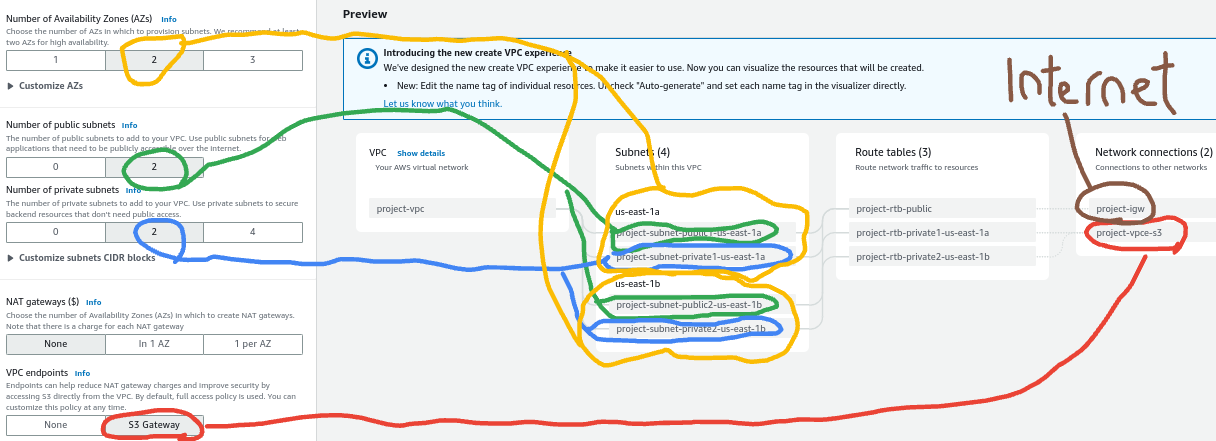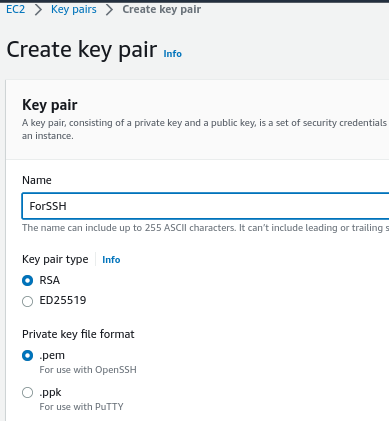Quick AWS EC2 VPC
Whenever you think of VPC, always think of EC2. VPC is the private lan for EC2.
- region eg. North Virginia (us-east-1)
- Availability Zones eg. { us-east-1a, us-east-1b…}
- Each Zone is a different data center
- Each Zone hosts at least 1 subnet
- Typically all Zones use the same Route-Table, Network ACL
- Availability Zones eg. { us-east-1a, us-east-1b…}
1 VPC
- A VPC is just a private LAN for you EC2s

NOTICE: the private subnets route to project-vpce-s3, this is a gateway to your AWS services. This allows you private subnets to access your AWS resources like s3 without touching the internet.
2 EC2 and ssh
2.1 Summary
Summary: To SSH, you need to generate a .pem private key via AWS UI.
The private key should be held in the local computer AKA user computer.
The public key should be held in the remote computer AKA AWS EC2 instance.
The public key is generated from the .pem private using a bash command that all linux PCs have meaning you will have to generate the public key on a local computer then copy it into your remote AWS EC2 instance.
2.2 instructions
- To ssh in your EC2 you MUST setup a keypair when initializing a EC2
- Private keys are Only generated once on creation through the UI, so if you forgot your private key you need to make a new one.
- Public key can be found if you enter the EC2 and go to `~/.ssh/
- Network&Security >> Key Pairs >> Create New Key
- However you can connect to EC2 with EC2 Instance Connect, However you must make sure you allow SSH access from the internet
- check this by looking at Network&Security >> Security Groups >> vpc-instance >> inbound-rules >> Port 22

- Drag your
ForSSH.pem(private key) into your openroot.com server sudo chmod 400 ForSSH.pemssh-keygen -y -f ForSSH.pem, this generates the public key which is shown below
ssh-rsa XXXXXXXXXXXXXXXXXXXXXXX+XXXXXXX/A/XXXXXXXXXXXXXXX - go to AWS console, connect via EC2 INSTANCE CONNECT in UI and
nano /.ssh/authorized_keys
add the text below, notice this is the public key we generated but we also added ForSSH label at the end
ssh-rsa XXXXXXXXXXXXXXXXXXXXXXX+XXXXXXX/A/XXXXXXXXXXXXXXX ForSSH- After doing do look in the UI, Network&Security >> Key Pairs and you should see an added ForSSH keypair.
- OPINION: I think it is strange the UI doesnt let you add the public key and we have to go directly into the EC2 machine to add it.
- Log-in via SSH from local computer using
ssh -i ./ForSSH.pem ec2-user@54.210.175.47with 54.210.175.47 being the public IP of the aws instance.
3 Setup
3.1 Download CLI
mkdir awstmp
curl "https://awscli.amazonaws.com/awscli-exe-linux-x86_64.zip" -o "awscliv2.zip"
unzip awscliv2.zip
sudo ./awstmp/aws/install
#You can now run: /usr/local/bin/aws --version
aws --version3.2 Create Administrator account
- check both boxes, programmatic access and web console browser access
- Add User “Administrator” with your custom password
- Make new group, “Administrator”
- Filter, add “AdministratorAccess” check
- Finish adding user, final page will show
- IAM id
- Username
- Access key ID: AKIAIOSFODNN7EXAMPLE
- Secret access key: wJalrXUtnFEMI/K7MDENG/bPxRfiCYEXAMPLEKEY
IAM id, Username and your custom password is used to logon browser.
Access key and Secret access key is used for code.
aws configure
AWS Access Key ID [None]: your_access_key_id
AWS Secret Access Key [None]: your_secret_access_key
Default region name [None]:
Default output format [None]:3.3 Download SAM
mkdir SAMtmp
wget https://github.com/aws/aws-sam-cli/releases/latest/download/aws-sam-cli-linux-x86_64.zip
unzip aws-sam-cli-linux-x86_64.zip
sudo ./install
sam --version3.3.1 Upgrade SAM
mkdir SAMtmp
wget https://github.com/aws/aws-sam-cli/releases/latest/download/aws-sam-cli-linux-x86_64.zip
unzip aws-sam-cli-linux-x86_64.zip
sudo ./install --update ##THIS IS THE ONLY DIFF from regular install
sam --version- Note SAM autodetects aws profile if you setup the aws cli
4 SAM
Common theme whether remote or local, we build the container locally.
Next step we can either call the local lambda or deploy it to AWS cloud.
sam build --use-container4.1 Local lambda call
- this emulate the aws cloud env locally as a docker
#local lambda invoke
sam local invoke "HelloWorldFunction" -e events/event.json4.2 Real AWS cloud deploy
#real lambda deploy
sam deploy --guided